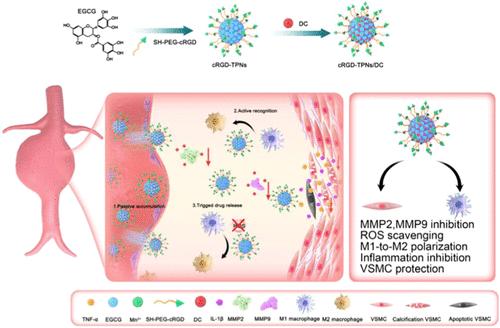生物活性茶多酚纳米颗粒用于腹主动脉瘤多功能治疗的精准给药
IF 8.2
2区 材料科学
Q1 MATERIALS SCIENCE, MULTIDISCIPLINARY
引用次数: 0
摘要
腹主动脉瘤(AAA)由于有破裂的可能,是一种严重的迫在眉睫的威胁,呈现出危及生命的场景。尽管急迫性,缺乏一种有效的临床药物来阻止动脉瘤生长和防止破裂。针对AAA病变中固有的复杂病理变化,本项目引入了一种多功能纳米药物,利用茶多酚纳米颗粒作为靶向AAA的多西环素(DC)的载体。通过SH-PEG-cRGD修饰,纳米颗粒(NPs)在AAA病变中的积累显著增加5倍,通过识别病变细胞膜上过表达的整合素αvβ3受体实现精确递送。这种纳米药物通过提高活性氧(ROS)水平,与纳米载体固有的抗氧化能力协同作用,在AAA位点实现可控的DC释放。综合作用包括抗炎、抗氧化、巨噬细胞复极化、抗凋亡和抗钙化能力,以及基质金属蛋白酶(MMP)抑制,有效解决各种aaa相关的病理变化和治疗。值得注意的是,纳米载体的递送显著减轻了DC引起的肝和肾毒性,突出了特殊的生物相容性。本研究提出了一种具有治疗动脉瘤巨大潜力的靶向纳米药物,并为开发各种血管疾病的靶向药物提供了蓝图。本文章由计算机程序翻译,如有差异,请以英文原文为准。

Precision Drug Delivery for Multifunctional Treatment of Abdominal Aortic Aneurysm Using Bioactive Tea Polyphenol Nanoparticles
Abdominal aortic aneurysm (AAA) poses a critical and imminent threat due to the potential for rupture, presenting a life-threatening scenario. Despite the urgency, there is a lack of an effective clinical drug to impede aneurysm growth and prevent rupture. Addressing the intricate pathological changes inherent in AAA lesions, this project introduces a multifunctional nanomedicine utilizing tea polyphenol nanoparticles as carriers for doxycycline (DC) targeted specifically to AAA. Through SH-PEG-cRGD modification, the nanoparticles (NPs) demonstrate a remarkable 5-fold increase in accumulation at AAA lesions, achieving precise delivery by recognizing the overexpressed integrin αvβ3 receptors on lesion cell membranes. This nanomedicine achieves controlled DC release at the AAA site triggered by elevated reactive oxygen species (ROS) levels, which synergizes with the inherent antioxidant prowess of the nanocarrier. The combined effect encompasses anti-inflammatory, antioxidant, macrophage repolarization, antiapoptotic, and anticalcification capabilities, along with matrix metalloproteinase (MMP) inhibition, effectively addressing diverse AAA-associated pathological changes and therapy. Notably, nanocarrier delivery significantly mitigates the hepatic and renal toxicity induced by DC, highlighting exceptional biocompatibility. This study propounds a targeted nanomedicine with substantial potential for aneurysm treatment and serves as a blueprint for the development of targeted drugs for various vascular diseases.
求助全文
通过发布文献求助,成功后即可免费获取论文全文。
去求助
来源期刊

ACS Applied Materials & Interfaces
工程技术-材料科学:综合
CiteScore
16.00
自引率
6.30%
发文量
4978
审稿时长
1.8 months
期刊介绍:
ACS Applied Materials & Interfaces is a leading interdisciplinary journal that brings together chemists, engineers, physicists, and biologists to explore the development and utilization of newly-discovered materials and interfacial processes for specific applications. Our journal has experienced remarkable growth since its establishment in 2009, both in terms of the number of articles published and the impact of the research showcased. We are proud to foster a truly global community, with the majority of published articles originating from outside the United States, reflecting the rapid growth of applied research worldwide.
 求助内容:
求助内容: 应助结果提醒方式:
应助结果提醒方式:


